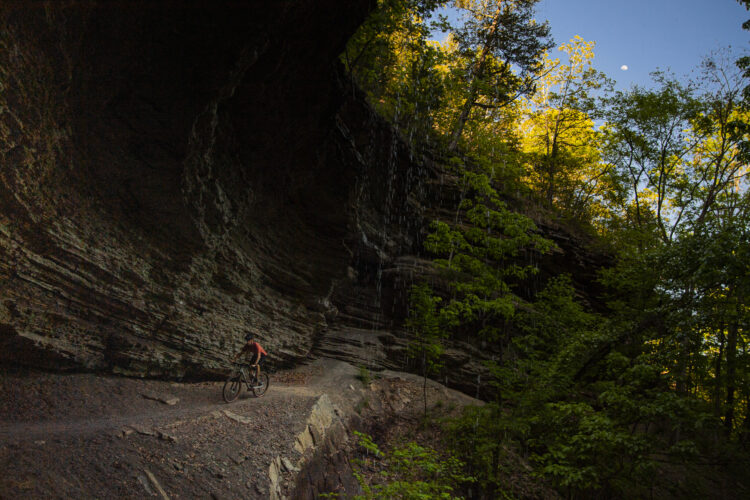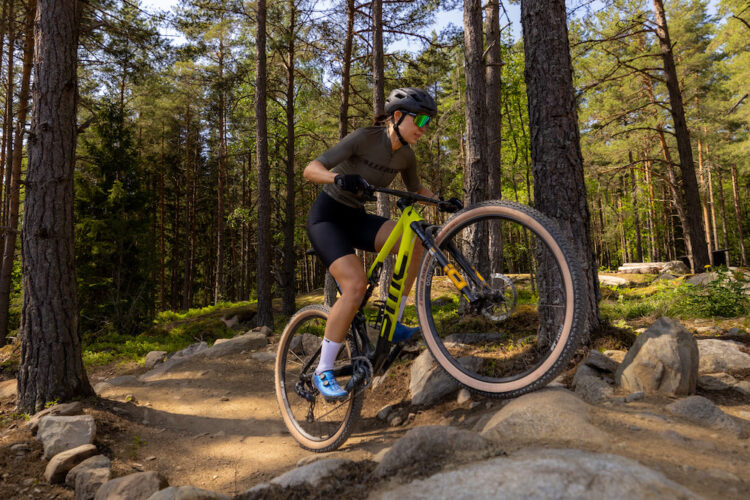
The Canyon Lux Trail is a longer-travel take on the brand’s lightweight, race-worthy full suspension XC bike, the Lux. Canyon positions the bike — with 120/110mm of suspension travel front and rear — as “everything a downcountry bike should be,” so naturally Singletracks had to give it a try. After putting in hundreds of miles of testing, here’s what I learned.
Canyon Lux Trail specs
Like the race-oriented Canyon Lux World Cup, the Lux Trail starts with a lightweight carbon frame that utilizes a single-pivot, flex-stay design. The Lux Trail delivers 110mm of rear suspension, and the two available builds both offer a 120mm fork up front.
Starting at the front of the frame, the Canyon Lux Trail has a 67.5° head tube angle, which is steep by downcountry standards where the average angle is just shy of 66°. Similarly, the 74.5° seat tube angle is an outlier among downcountry bikes, sitting slacker by about a degree and a half compared to the average. The 500mm reach on the size extra large I tested is notably longer than most downcountry bikes, while the 435mm chainstays are right in line with other bikes in the category.

The Canyon Lux Trail is a 29er and can accommodate rear tires up to 2.4″ wide. My test bike is running 29×2.35″ Racing Ralphs and I wouldn’t want to run anything wider given the available frame clearance.
The good news for riders on smaller frames is that the Lux Trail can fit a 150mm travel dropper post. The bad news for tall riders is that largest frames list the exact same unimpeded seat tube length and minimum and maximum seat post insertion lengths as the smallest ones, and all builds ship with the same 150mm post.


Canyon managed to squeeze not one but two sets of bottle cage mounts inside the front triangle. No, the Lux Trail doesn’t have any sort of fancy in-frame storage built into the downtube, but with so many stash tool, frame bag, and bottle cage options available aftermarket, these two sets of mounts are sure to come in handy. The only weird thing — and maybe it’s just bad luck on my part — is that every single Canyon I’ve ever tested fails to include bottle cage bolts with the frame. It’s not impossible to find bolts that fit, but it is an extra hassle I’d prefer to avoid.
Thanks to its relatively simple suspension design, there aren’t a lot of places for mud and crud to collect, making it easy to keep the Lux Trail frame running clean and mean. The frame features internal cable routing at the head tube for a tidy look and a rattle-free ride.

The build
My test bike is the Canyon Lux Trail CF 7, the more expensive of the two builds currently on offer. If the geometry sorta hints that the Lux Trail sits toward the XC end of the downcountry spectrum, this build kit surely confirms it.
Perhaps the first thing riders will notice at the cockpit is the lockout remote that controls both the front and rear shocks. Racers in particular will appreciate the ability to quickly and easily lock the suspension for climbing in one swoop, though most everyday trail riders are likely just as willing to reach down and flip the shock or fork controls as necessary based on the terrain.



The lockout remote, while a nice feature, requires a compromised over-the-bar dropper control that brings back old memories of 2X drivetrains and early dropper posts. (To be clear, the Canyon Lux Trail is not compatible with a front derailleur.) This suggests that making use of the dropper post is a lesser priority than ensuring pedal efficiency of the bike. Not that there’s anything wrong with that; it’s just very XC-like.
And that’s not all. The Canyon Lux Trail features a chain keeper to reduce the chances of a dropped chain and precious seconds lost in a tight race. Both builds ship with a stout 34t chainring to go with the 12-speed cassette, which is Shimano XT on the CF 7 build I tested.
Up front the Canyon Lux Trail CF 7 comes with a 120mm Fox 34 Stepcast Performance Elite fork, a 760mm-wide Race Face Riserbar, and 60mm Race Face Ride stem. The wheels are DT Swiss XRC 1700s wrapped in a Schwalbe Wicked Will tire up front and a Racing Ralph in the rear. Shimano XT two-piston brakes with 180/160mm rotors front and rear, a 150mm Fox Transfer dropper post, and Fox Float DPS Performance Elite shock round out the build.

There’s a block attached to the top tube to limit the bike’s steering, and while I’m normally not a fan of limiters, this one proves to be quite generous, allowing the bars to sweep a nice wide arc. Only at the most extreme angle does the limiter come into play, preventing the bars and fork from smacking into the frame.
Size small frames come with 170mm-long XT crank arms while sizes medium and up ship with 175mm cranks. Altogether my size XL test bike weighs 12.54kg (about 27.6lb) with pedals.

On the trail with the Canyon Lux Trail
Looking at the Canyon Lux Trail specs, it’s clearly an outlier among bikes that claim the downcountry label. Most of us associate downcountry with bikes that sit at the short-travel end of the trail bike spectrum, and that’s a decent generalization. The Lux Trail, on the other hand, is more of a long-travel XC bike. It might sound like those are two sides of the same coin, but I’m now convinced it’s a real and important distinction. So much so that it took me quite some time to adjust to the Canyon Lux Trail immediately following my long term test of the Evil the Following, even though the two bikes have the exact same reach and wheelbase numbers, for example.
Reviewer profile height: 190cm (6’3″) weight: 72.5kg (160lb) testing zone: Southeast, USA
The 67.5° head angle and 74.5° result in a notably extended top tube length, forcing riders into a more stretched position on the bike. It feels racy for sure, and likely provides an aerodynamic advantage over a more upright (and frankly more comfortable) position. But muscle memory is an interesting thing. After several weeks of riding this bike, the position not only started to feel more natural, it felt faster too.

That steep-for-a-trail-bike head angle aids the bike’s climbing abilities, which are formidable. I’m still pissed that Strava bungled the timing when I rode the President Bush Push climbing segment in Bentonville. Ask anyone who was there; I blasted up the steep, rocky, and loose fire road like I was rushing up a set of stadium steps to the front of the restroom line during the seventh inning stretch. E-bike riders like to talk about uphill flow, and this is one non-electric that actually delivers it. You can’t help but bound and slash your way uphill over rocks and roots.
Pedaling the Canyon Lux Trail across flat and rolling trails the bike feels poppy and snappy. Digging into the pedals the power transfer is quick, and the suspension feels supportive, even when it’s fully open. The light weight, particularly at the front end, begs popping off every root and every lip. Much to my own surprise, I guess I’m saying that I found the Lux Trail to be playful, despite my initial impressions and specs that suggest it’s basically a toned down XC race bike.

Because the top tube is long, it places the rider in a lower position as they stretch to reach the bars. For me this made the bike feel small for its size, or at the very least low to the ground. (In fact the 38mm bottom bracket drop is just a smidge lower than the average downcountry bike.) The upshot is a lower center of gravity overall and again, a playful feel if you can get the dropper post low enough. I definitely would have appreciated a longer post, and regularly found myself double checking to make sure I had the post down as low as it could go.
On the descents the Canyon Lux Trail doesn’t feel super planted, nor is it very harsh or twitchy. I set up the suspension to be fairly soft and responsive, hardly what one might choose for racing. The lightweight, supple tires do a good job smoothing the trail as well, and overall the Lux Trail is well suited to launching off bumps in the trail as opposed to plowing through them or risking hard landings.
The Canyon Lux Trail proved to be a good choice for riding my local trails, and also for sampling some of the best singletrack in Northwest Arkansas on a recent trip. Given the wide-open front triangle on my XL test bike the Lux Trail is a bike that would make my short list for a full suspension bikepacking rig capable of tackling days of technical singletrack in addition to serving well as a weekday rider.
Pros and cons of the Canyon Lux Trail
Pros
- Lightweight and efficient pedaler
- Comfortable and capable descender
- Great value
Cons
- Geometry is not particularly progressive
- Needs a better dropper remote
- Only one frame color available with the CF 7 build
Bottom line
Admittedly I wasn’t stoked on the Canyon Lux Trail at first, but it really grew on me the more I rode it. For XC racers this bike makes a lot of sense, but for trail riders it appears to be an odd bird given its stuffy geo and hobbled dropper controls. Personally I wouldn’t call the Lux Trail a downcountry bike, though in practice it fills an adjacent niche for riders who want a fast, fun, and lightweight bike to ride most trails, and for a very good price.
- Price: $4,399 as tested. Builds start at $3,399.
- Buy from canyon.com
Updated 5/12 to clarify that the unimpeded seat tube lengths are listed as the same across all frame sizes.





